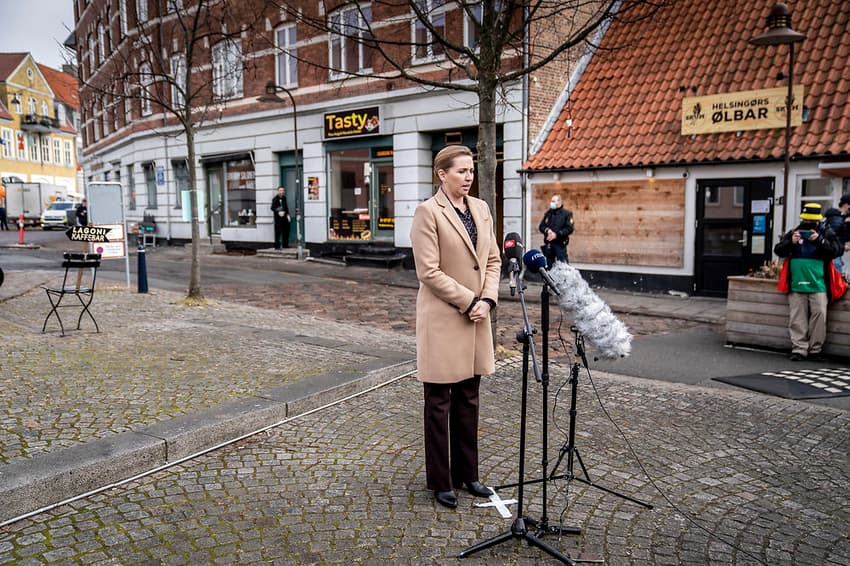Danish PM hints at change to Covid-19 vaccination programme

Prime Minister Mette Frederiksen has suggested that Denmark may soon make changes to its vaccination programme.
Frederiksen commented on the country’s current schedule for inoculation the country against the virus on Monday while visiting re-opened shops in coastal town Helsingør.
“The vaccination plan states, at one point, 65 years. On that, I can say today that 65 is set too high when we look at who is at risk of hospitalisation and more serious illness. We should be under 65 for this, probably at 50,” she said somewhat cryptically
“But (health) authorities are going to release more specific information,” she added.
The Danish Health Authority has divided the population into 12 priority groups for the vaccination programme. Age is one of the factors by which the groups are divided.
READ ALSO:
What is Denmark’s current schedule for Covid-19 vaccination?
When and how can foreign residents get the Covid-19 vaccine in Denmark?
Although Frederiksen did not elaborate on which groups she was referring to, the age group 65-74 years is currently ninth in the 12-group classification for receiving the coronavirus vaccine. People aged 16-64 with no underlying risk factors are in the final, twelfth group.
As such, those may be the groups the PM was talking about.
The government is currently discussing possible long-term reopening plans and Frederiksen is reported to have met with Jakob Ellemann-Jensen, leader of the Liberals, the largest opposition party, on Monday.
Ellemann-Jensen has called for Denmark to take gradual steps towards reopening every two weeks if that is supported by infection rates. He also wants a full reopening in May if everyone over the age of 50 has been vaccinated by then, as well as people in risk groups.
“When we reach the point at which everyone over 50 has been vaccinated in Denmark, as has everyone who might be in a risk group because of another illness, we will hopefully be in a different situation to the one we are in now,” Frederiksen said.
“That depends on how (the infection situation with) mutations develops. But we would have a different starting point, and that’s where we’d work from,” she added.
Comments
See Also
Frederiksen commented on the country’s current schedule for inoculation the country against the virus on Monday while visiting re-opened shops in coastal town Helsingør.
“The vaccination plan states, at one point, 65 years. On that, I can say today that 65 is set too high when we look at who is at risk of hospitalisation and more serious illness. We should be under 65 for this, probably at 50,” she said somewhat cryptically
“But (health) authorities are going to release more specific information,” she added.
The Danish Health Authority has divided the population into 12 priority groups for the vaccination programme. Age is one of the factors by which the groups are divided.
READ ALSO:
What is Denmark’s current schedule for Covid-19 vaccination?
When and how can foreign residents get the Covid-19 vaccine in Denmark?
Although Frederiksen did not elaborate on which groups she was referring to, the age group 65-74 years is currently ninth in the 12-group classification for receiving the coronavirus vaccine. People aged 16-64 with no underlying risk factors are in the final, twelfth group.
As such, those may be the groups the PM was talking about.
The government is currently discussing possible long-term reopening plans and Frederiksen is reported to have met with Jakob Ellemann-Jensen, leader of the Liberals, the largest opposition party, on Monday.
Ellemann-Jensen has called for Denmark to take gradual steps towards reopening every two weeks if that is supported by infection rates. He also wants a full reopening in May if everyone over the age of 50 has been vaccinated by then, as well as people in risk groups.
“When we reach the point at which everyone over 50 has been vaccinated in Denmark, as has everyone who might be in a risk group because of another illness, we will hopefully be in a different situation to the one we are in now,” Frederiksen said.
“That depends on how (the infection situation with) mutations develops. But we would have a different starting point, and that’s where we’d work from,” she added.
Join the conversation in our comments section below. Share your own views and experience and if you have a question or suggestion for our journalists then email us at [email protected].
Please keep comments civil, constructive and on topic – and make sure to read our terms of use before getting involved.
Please log in here to leave a comment.